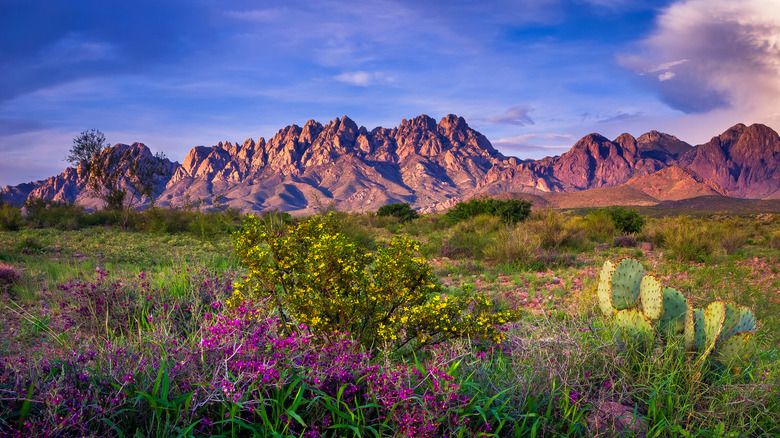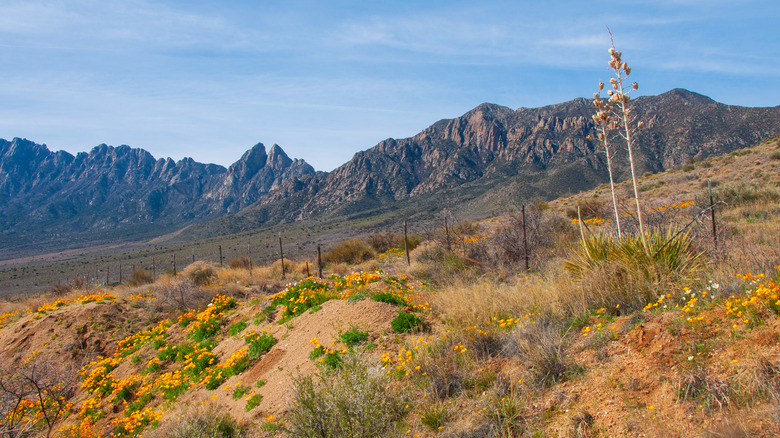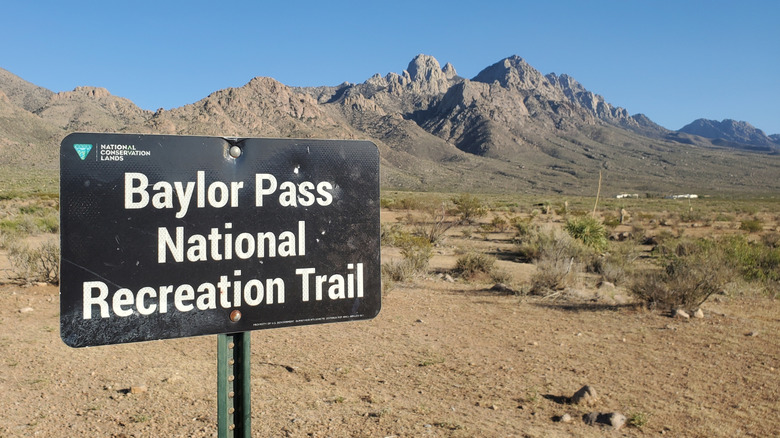Camp For Free At This Stunning New Mexico Destination Nestled At The Foothills Of Breathtaking Mountains
Toward the northwestern edge of the Chihuahuan Desert in New Mexico sits a dramatic range called the Organ Mountains. Narrow canyons cut between steep, jagged peaks that reach up to 9,000 feet. It's a popular destination for soaking in picture-perfect panoramas and vivid wildflower blooms. It also offers views of the surrounding landscape that vary from expansive desert habitat to stands of ponderosa pine at higher elevations.
One of the best parts of visiting this series of areas overseen by the Bureau of Land Management (BLM) — which includes the Organ Needles Wilderness Study Area, Organ Mountains Wilderness Area, and the Organ Mountains-Desert Peaks National Monument — is that camping within them is free (with some caveats). "Dispersed camping" is the term that BLM uses to denote free-of-charge, primitive camping on public land outside of designated campsites, culturally or ecologically significant areas, or military sites.
So, as long as you follow a certain set of rules, you can enjoy the wilderness in a truly undiluted way. You'll need a car to reach this spectacular mountain wilderness, located a 25-minute drive east of Las Cruces, one of New Mexico's sunniest cities. The area is about an hour's drive from El Paso, Texas, and around four hours from Albuquerque.
Free camping in the Organ Mountains area
Dispersed camping is permitted throughout the BLM boundary, provided you follow some basic guidelines. You can set up camp for up to 14 cumulative days within a 28-day period before needing to relocate to another location at least 25 miles away. Dispersed camping areas are "camping sites" to the degree that they show evidence of previous use. More often than not, they simply resemble a gravel parking spot.
There are plenty of dispersed camping options within the BLM-managed lands in the Organ Mountains to choose from, ranging from trailhead parking lots to pulloffs along the road. These sites are ideal for RVs or vans, but you can't go wrong with just pitching a tent. Great ways to find specific sites include platforms like Ioverlander and Free Campsites, where users review site amenities, suitability for various travel rigs, pet friendliness, and cell phone signal strength, which happens to range from fair to great throughout much of the Organ Mountains.
One paid camping option in the area is the Aguirre Spring Recreation Area and Campground, located on the Organ Mountains' eastern side. This area offers 55 first-come, first-served sites at only $7 per night. You'll get the best of two worlds: sites at the base of a dramatic crescent formation of pointy peaks and vast views across White Sands National Park. As the only upland campground in the Las Cruces region, Aguirre Spring is a popular camping destination for locals on weekends, so get there early to select your site and check in at the self-serve kiosk, which accepts cash or card.
Hiking in the Organ Mountains
The Organ Mountains sit amid the expansive Chihuahuan Desert — the most biologically diverse desert ecosystem in the entire Western Hemisphere. If you're headed to or from West Texas' Big Bend National Park, a beautiful, under-the-radar gem, you'll travel through the heart of this marvelous landscape. Thankfully, the area has plenty of trails to take in the surrounding beauty.
Whether you set up camp right away or can't wait to hit the dirt, add Pine Tree Trail to your list. This very popular, 4-mile loop is moderately challenging, with an elevation gain of just a little more than 1,000 feet. Marvel at expansive views of open desert and craggy peaks, or take your time watching for songbirds and identifying botanicals like mountain mahogany trees and sotol succulents.
Organ Mountains Wilderness Area also encompasses the Baylor Pass National Recreation Trail if you're in the mood for something a bit more lengthy. Considered a difficult in-and-out route at almost 11 miles one way, you'll gain 2,375 feet of elevation as you cruise through the namesake mountain pass and observe the area's renowned, spire-like peaks. It typically takes around five-and-a-half hours to complete this trek, and it's worth mentioning that you'll be moving through some pretty high-altitude areas. If you've just arrived, remember to drink lots of water and rest often so you can make the most of these scenic walks.


